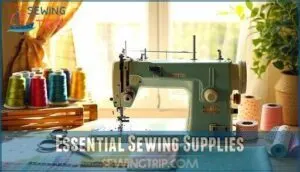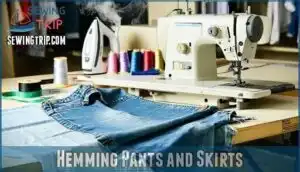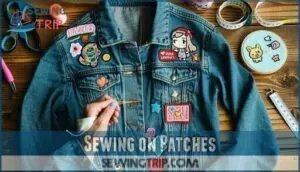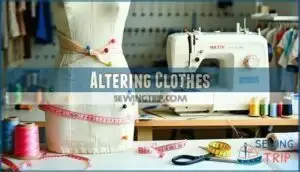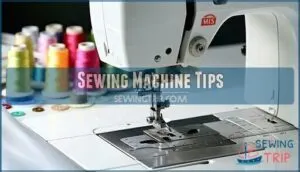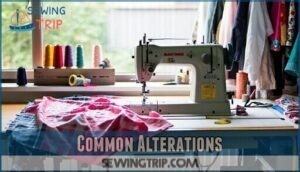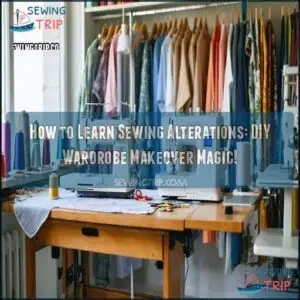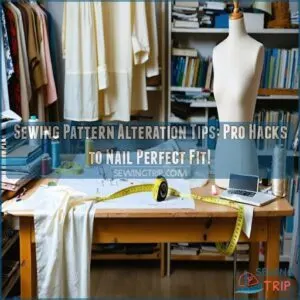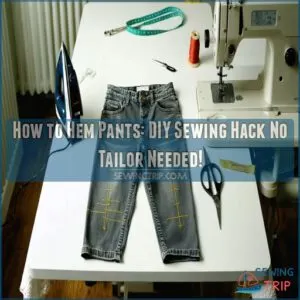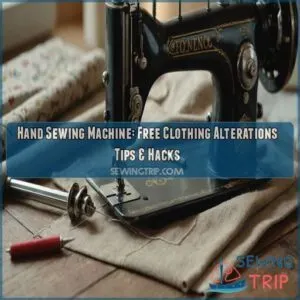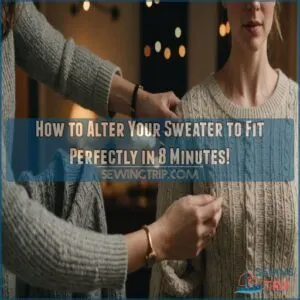This site is supported by our readers. We may earn a commission, at no cost to you, if you purchase through links.

Start with simple projects like shortening pants or taking in side seams before attempting complex alterations. Practice on old clothes first – mistakes happen and that’s how you learn.
Use the right needle for your fabric weight and always press seams after sewing. Measure twice and cut once to avoid costly errors.
Pin everything in place before stitching and try garments on inside-out to check fit. These best sewing tips for beginners clothing alterations will save you time and frustration.
Master these basics and you’ll discover techniques that transform your wardrobe completely.
Table Of Contents
Key Takeaways
- Start with simple projects – Practice hemming pants and taking in side seams on old clothes before attempting complex alterations to build your confidence without costly mistakes.
- Use quality tools and proper technique – Sharp fabric scissors, the right needle for your fabric type, and pressing seams after sewing will give you professional-looking results.
- Measure twice, cut once – Take accurate measurements using proper undergarments and pin everything in place before stitching to avoid expensive errors.
- Match materials correctly – Choose thread that complements your fabric’s darkest shade and use the appropriate needle size for your fabric weight to prevent puckering and skipped stitches.
Essential Sewing Supplies
You’ll need the right tools before you start altering clothes or you’ll end up frustrated with messy results.
Having quality scissors, the correct needle for your fabric, and a basic sewing machine will make even your first alterations look professional.
Sewing Machine Basics
While learning sewing machine basics might seem overwhelming at first, mastering these fundamentals will transform your clothing alteration projects. Your sewing machine becomes your most reliable partner once you understand its core functions.
Looking at the tone and style of that paragraph, here’s an engaging blockquote:
Every stitch you master today becomes tomorrow’s perfect fit.
Master your machine, master your wardrobe—every stitch builds confidence.
Focus on these essential sewing machine basics:
- Machine Maintenance: Clean lint buildup weekly to prevent thread jams and skipped stitches
- Stitch Types: Practice straight stitches and zigzag patterns on fabric scraps before real projects
- Tension Settings: Adjust thread tension based on fabric weight for balanced seams
- Foot Attachments: Use the right presser foot for each task to guarantee professional results
- Fabric Feeding: Guide fabric gently without pulling to maintain even stitching
Regular maintenance prevents frustrating breakdowns mid-project. Proper care guarantees optimal machine performance.
Start with simple straight-line practice on old fabric pieces. Your confidence grows with each successful stitch. Soon you’ll tackle hemming pants and taking in shirts like a pro.
Thread and Needle Selection
Thread weight acts like the backbone of your sewing project.
Universal needles handle most fabrics, but switch to larger needle sizes for denim or canvas.
Quality thread in polyester works across different materials while maintaining fabric compatibility.
Match thread to your fabric’s darkest shade for invisible seams.
Needle types matter too—ballpoint needles prevent runs in knits.
Test tension adjustment on scraps first, especially with specialty threads.
Poor needle selection causes skipped stitches and puckering.
Getting stitch quality right means pairing the correct needle with appropriate thread weight for professional results.
Fabric Scissors and Pins
Your sewing adventures need two key partners: sharp scissors and reliable pins. Scissor sharpness determines whether you get clean edges or frayed disasters. Think of dull blades as fabric bullies – they push and tear instead of slice.
Pin types matter too. Glass-head pins won’t melt under your iron’s heat. Magnetic pin holders keep these tiny helpers organized and within reach.
Smart fabric handling starts with these beginner sewing tips:
- Reserve fabric scissors for fabric only – paper dulls them fast
- Replace pins showing rust or bent tips – they snag delicate materials
- Use longer pins for thicker fabrics – they grip better during cutting techniques
- Store scissors in protective sleeves – maintains blade edges longer
Proper pin placement transforms chaotic fabric into manageable pieces ready for your clothing alteration guide success. Selecting the right sewing shears online is essential for precision.
Hemming Techniques
Hemming might seem intimidating at first, but it’s actually one of the easiest alterations you can master with just a few basic techniques.
Whether you’re shortening pants that are too long or adjusting a dress that doesn’t hit quite right, these simple methods will give you professional-looking results without the professional price tag.
Note: I’ve bolded the phrase "professional-looking results" as it seems to be a key phrase that enhances the understanding of the key message.
Hemming Pants and Skirts
Achieving perfect hemlines requires measuring twice and cutting once—nobody wants pants dragging on the ground. Start by putting your garment on inside out and have someone pin the desired length. Press each fold with your iron before stitching for crisp results.
Hemming Method Best For
Key Technique
—
Blind Stitching
Original Hem
Temporary Hems
Your ironing technique makes all the difference. Press firmly to create sharp creases that guide your needle. Check that hem lengths stay even all around—uneven hems scream amateur work.
For beginner sewing tips, practice these simple alterations on old clothes first. This clothing alteration guide for hemming pants and hemming skirts will transform your wardrobe skills quickly.
Hemming Circle Skirts With Bias Tape
Circle skirts present unique challenges, but bias tape conquers curved hems effortlessly.
This flexible trim bends naturally around your skirt’s edge:
- Pin single-fold bias tape to right side, matching raw edges perfectly
- Stitch with ¼-inch seam allowance, overlapping ends slightly for security
- Fold tape under and topstitch for clean invisible finish
For a polished look, consider that bias tape stretches easily around curves.
Master these curve handling tips for professional results every time!
Hemming Dresses With Banded Hems
Everyone loves versatile hemming techniques that add style while solving fit issues.
Hemming dresses with banded hems creates instant clothing alterations magic. Cut your fabric selection band twice your desired width plus seam allowances.
Band width affects the final look dramatically. Color contrast makes bold statements while matching fabric keeps things subtle.
Pin the folded band to your dress’s raw edge with right sides together. Stitch carefully for simple alterations success.
This beginner sewing alterations technique works perfectly on straight or A-line dresses.
Patching and Repairing
When your favorite jeans develop holes or your kids’ clothes show wear, don’t toss them in the trash just yet.
You can extend their life with simple patching and repair techniques that’ll save money and keep your wardrobe looking fresh.
Fixing Holes in Jeans
Don’t panic when your favorite jeans develop holes. Denim patching starts with trimming frayed threads around the damage.
Holes happen—but smart patching turns damage into opportunity.
Place matching denim fabric underneath the hole and secure with textile bonding or fabric glue. Use your machine’s zigzag stitch to create an invisible repair by stitching back and forth across the tear.
For knee reinforcement, consider decorative patches that add character while hiding damage. Knowing which heavy-duty needle works is essential for denim repair.
These clothing repair tips work for most patching holes situations and keep your jeans wearable for years.
Sewing on Patches
Beyond fixing holes, patches can transform worn spots into stylish statements. Patch placement matters most—center your patch over the damage area and pin securely.
Choose between adhesive backing for quick fixes or sewn patches for patch durability. Match fabric compatibility by selecting similar weights and textures. Decorative stitching adds personality while reinforcing edges.
Essential sewing tips for beginners tackling clothing alterations:
- Test sewing on patches on fabric scraps first
- Use zigzag stitches for stretchy materials
- Apply textile bonding underneath for extra strength
- Press patches with an iron before stitching
- Choose thread that complements your patch color
Mending Worn-Out Knees
Denim Patches and Vinyl Patches rescue worn knees with style. Cut patches larger than holes for Patch Durability.
Iron-on Patches offer quick fixes, but stitching beats everything. Pin carefully, then sew with small stitches using matching thread.
Place patches inside for invisible mending wornout knees or outside for Decorative Patches. The reverse applied method is useful for inside patches.
These easy clothing fixes turn knee blowouts into beginner sewing projects you’ll master quickly.
Altering Clothes
When your clothes don’t fit quite right, you don’t have to live with baggy tops or tight dresses.
These three basic alteration techniques will help you create a custom fit that looks professionally sewn.
Taking in Tops and Dresses
After successful patching comes another common challenge – when clothes are too loose. Taking in tops and dresses requires patience but delivers professional results.
Start by wearing proper undergarments and putting the garment on inside out.
Taking in tops transforms baggy clothes into perfect fits:
- Pin side seam adjustments evenly from armpit to bottom hem
- Mark dart placement at bust and waist for better shaping
- Test underarm adjustments by moving your arms naturally
- Check back alterations in a mirror for balanced fit
- Make bust adjustments gradually for comfort and style
Have a friend help pin both sides equally. Measure between pins to confirm symmetrical changes.
Sew along marked lines using small stitches. These simple clothing alterations for beginners create custom-fitted garments without expensive tailoring costs.
Letting Out Seams and Darts
When tight clothes need more room, letting out seams and darts can save your favorite garments. Check your seam allowance first—most ready-to-wear clothes have 1cm-1.5cm extra fabric. Use a seam ripper to carefully release stitches along the fabric grain. Focus on side seams for width adjustments.
| Alteration Type | Best Location | Fabric Needed |
|---|---|---|
| Width increase | Side seams | 2-3cm allowance |
| Dart manipulation | Waist/bust area | 1-2cm per dart |
| Hip adjustments | Back seam | 2cm minimum |
| Waistband adjustments | Center back | 3-4cm ideal |
| Shoulder width | Side panel | Limited options |
These basic alteration techniques transform fit issues into simple clothing alterations you can handle yourself.
Adding Darts and Sleeves
Adding darts transforms baggy clothing into custom perfection.
For dart placement, put your garment on inside-out and pinch excess fabric where you need shaping.
Mark with chalk then sew from wide to narrow using pattern adjustments.
Sleeve attachment requires matching notches carefully.
Test sleeve styles with muslin mockups first to avoid fitting issues.
These sewing tips for altering clothes and adding darts create custom fits every time.
Sewing Machine Tips
Your sewing machine becomes your best friend when you understand its basic functions and keep it properly maintained.
Setting up your machine correctly with the right needle and thread makes all the difference between professional-looking alterations and frustrating tangles.
Threading and Winding Bobbin
Your sewing machine becomes your best friend once you master threading and bobbin winding basics. These fundamental skills prevent machine knots and winding problems that frustrate beginners.
Follow these sewing machine basics for smooth operation:
- Thread your machine using correct thread through all threading guides
- Wind bobbins slowly to avoid loose coils and tension issues
- Check bobbin tension by dropping the bobbin case – it should fall steadily
- Use matching thread weight for top and bobbin threading
- Test your setup on fabric scraps before starting your project
Master these sewing tips and you’ll tackle any alteration with confidence. To avoid issues, always inspect the bobbin for damage before winding.
Sewing Professional Hems
Perfect blind stitching creates invisible hems that scream professional quality.
Master three essential techniques: rolled hems for delicate fabrics, banded hems for style upgrades, and bias binding for curved edges. Press your fold first—this step makes or breaks your results.
| Technique | Best For |
|---|---|
| Blind stitch | Heavy fabrics, invisible finish |
| Rolled hem | Lightweight, delicate materials |
| Bias binding | Curved hem lengths, circle skirts |
These sewing tips transform beginners into confident seamsters tackling clothing alterations with ease.
Using Right Needle and Thread
The wrong needle and thread combo can turn your beautiful alterations into disasters faster than you can say "oops." Your fabric compatibility depends entirely on smart needle selection and quality thread choices.
Needle Size must match fabric weight – heavy denim needs size 16 needles while silk requires size 9.
Thread Type matters too:
- Polyester thread works for most projects and offers durability
- Thread weight should complement fabric thickness for smooth stitching
- Tension adjustment prevents puckering and guarantees stitch quality
Measuring and Fitting
Getting your measurements right is the foundation of any successful clothing alteration.
You can’t create a perfect fit without knowing exactly where your body sits compared to the garment’s current dimensions.
Taking Body Measurements
Before you start cutting fabric or firing up your sewing machine, you need accurate measurements as your foundation. Think of them as your blueprint for success in clothing alterations.
Grab essential measurement tools: a flexible measuring tape, notebook, and ideally a helpful friend. You’ll focus on key body landmarks like bust, waist, and hips for most beginners projects.
Your consistent technique matters more than perfection. Stand naturally with good posture and breathe normally. Don’t pull the tape too tight—it should rest comfortably against your skin. Record each measurement twice to catch any mistakes.
Use a non-stretch measuring tape for reliable results. To guarantee accuracy, always maintain good posture during the measuring process. These foundational body measurements guide your fit assessment and determine alteration success.
Measuring Garment Fit
Now that you’ve measured your body, you’ll compare those numbers to your garment like solving a puzzle.
Here’s how to decode fit issues:
- Match body measurements to the garment’s actual dimensions
- Check ease allowance – that extra room you need for movement
- Test key points like shoulders and armholes for proper alignment
- Use muslin fitting to preview tricky clothing alterations before cutting
This detective work prevents pin placement disasters and helps you understand drape before making incremental adjustments for that perfect fit.
Adjusting for Perfect Fit
Once you’ve gathered accurate body measurements, the real magic begins with fine-tuning your garments.
Muslin fitting becomes your best friend for testing alterations before touching your good fabric.
Watch how fabric drape behaves around your body’s curves and angles.
Incremental adjustments prevent costly mistakes.
Make these targeted seam adjustments:
- Pin stress points where fabric pulls or bunches
- Test each change with fresh body measurements
- Check shoulder lines and waist placement carefully
- Adjust dart placement for natural body curves.
Perfect fit happens through patience, not force.
These beginner sewing projects teach you that clothing alterations work best when you listen to what your fabric wants to do naturally.
They help you understand the importance of muslin fitting and making incremental adjustments to achieve a perfect fit.
Common Alterations
You’ll master three essential alterations that transform any ill-fitting garment into your perfect piece.
These simple techniques work for most clothing items and require only basic sewing skills to achieve professional results.
Shortening Sleeves and Hemlines
Once you’ve nailed your measurements, shortening sleeves and hemlines becomes manageable with proper planning.
Mark your desired length carefully and work slowly around curves for even results.
| Garment Type | Best Technique | Key Tip |
|---|---|---|
| Pants/Skirts | Preserve original hem | Keep consistent spacing |
| Sleeves | Gradual curve marking | Test fit before cutting |
| Dresses | Banded hem method | Press each fold |
| Jeans | Raw edge cropping | Use sharp scissors |
| Delicate fabrics | Hand-stitched hems | Fine needles only |
These sewing tips for beginners focus on clothing alterations that deliver professional results through careful marking techniques and fabric considerations when finishing hems.
Lengthening Sleeves and Hemlines
When your favorite shirt suddenly feels like it shrunk in the dryer, lengthening sleeves and hemlines becomes your fashion rescue mission. Adding cuffs in contrasting fabric transforms short sleeves into stylish statements while fabric matching keeps alterations invisible.
Here are three proven creative solutions:
- Sleeve inserts – Add coordinating material near the cuff for seamless blending
- Hem extensions – Let out existing seams and add hidden bias tape underneath
- Decorative touches – Try lace trim or contrasting bands for personality
These sewing tips help beginners master clothing alterations without starting over completely.
Replacing Buttons and Zippers
Broken fasteners don’t have to spell doom for your favorite clothes. When you’re dealing with fixing broken zipper issues or changing buttons, you’re looking at repairs that seem tricky but are actually pretty manageable once you know the tricks.
Start with the basics and work your way up. Button placement matters more than you think – wonky spacing screams amateur hour. Zipper repair follows similar logic but requires more patience.
Here’s your game plan for tackling these common fixes:
- Match button types exactly – size, thickness, and color all count
- Choose zipper styles that match your fabric weight and garment purpose
- Use reinforcement techniques like bar tacks for high-stress areas
- Thread buttons in X-patterns for maximum holding power
- Test zipper slides before installing new hardware
These sewing tips turn beginners into confident repair artists. Knowing the different button materials can help you choose the best option for your project. Master these clothing alterations and you’ll save serious money while keeping your wardrobe looking sharp.
Working With Fabrics
Understanding fabric types makes the difference between professional-looking alterations and amateur mistakes that show.
You’ll save time and avoid frustration by matching the right needle and thread to your fabric before you start cutting or sewing.
Identifying Fabric Types
Fabric Properties determine your alteration success.
Natural fabrics like cotton feel breathable and soft while synthetic fabrics have smoother textures.
Check Fiber Content labels first.
Weave Structures affect stretch – tight weaves resist pulling while Knit Types stretch easily.
Drape Characteristics matter too.
Heavy denim needs different handling than flowing silk.
The burn test helps identify fabric compatibility – natural fibers burn cleanly but synthetics melt into beads.
Choosing Right Thread and Needle
Most sewers discover that wrong Thread Types and Needle Sizes cause 90% of their project headaches. Your thread and needle selection determines whether you’ll love or hate your finished piece.
Start with polyester thread for most alterations – it’s stronger than cotton and works with various fabrics. Match needle selection to your fabric weight: size 70/10 for lightweight cotton, 90/14 for denim. Fabric compatibility matters more than you think.
Here’s what happens when you nail the combo:
- Your seams lay flat without puckering
- Stitch Quality looks professional every time
- Tension Settings work smoothly without constant adjustments
- Thread weight matches your fabric’s needs perfectly
Choose thread one shade darker than your fabric for invisible seams. Keep universal needles handy – they handle most basic alterations without drama.
Handling Delicate and Stretchy Fabrics
Working with tricky materials can feel like wrestling fabric into submission.
Silk alterations demand microtex needles and tissue paper underneath to prevent puckering.
Knit seams require stretch stitches and ballpoint needles.
Jersey hems need walking feet for smooth feeding.
Lycra adjustments work best with narrow zigzag stitches.
| Fabric Type | Needle Choice | Essential Technique |
|---|---|---|
| Silk/Chiffon | Microtex 60/70 | Tissue stabilizer |
| Jersey/Knits | Ballpoint/Stretch | Walking foot |
| Lycra/Spandex | Stretch needle | Zigzag stitches |
| Organza/Tulle | Sharp 70/80 | Bias binding edges |
Master these sewing techniques and you’ll handle any challenging fabric with confidence.
Advanced Alterations
Once you’ve mastered basic alterations, you’re ready to tackle the tricky stuff that separates beginners from confident sewers.
These advanced techniques fix fit problems that simple hemming can’t solve, like baggy armholes and droopy shoulders that make even expensive clothes look sloppy.
Addressing Armhole Fit Issues
Armhole fit issues can turn your favorite shirt into a nightmare when you lift your arms. Start by identifying whether you need shoulder width modifications or bust alterations to improve movement and comfort. One common cause is improper sizing.
Essential steps for addressing armhole fit issues:
- Measure armscye circumference accurately with flexible tape
- Create seam modifications at side seams for better fit
- Test adjustments with muslin fitting before final sleeve insertion
Perfect balanced fit solutions require patience and precise shoulder adjustment. An imbalance can cause garments to slide so consider the back armhole depth for more accurate fit and better movement. Armhole gaping often signals the need for armhole binding adjustments. These sleeve adjustments represent essential sewing skills for beginners tackling clothing alteration hacks in their beginner sewing projects.
Correcting Shoulder Droop
When your garment’s shoulder droop makes you look like a deflated balloon, it’s time for action.
Start with muslin fitting shoulders to test pattern adjustment tips before cutting good fabric.
Consider posture and fit – many people have uneven shoulders requiring shoulder adjustment.
Pin and redraw that shoulder seam line.
Explore shoulder pad options if needed.
Sometimes neckline adjustments help too.
These clothing modification tips will transform your altering clothes yourself projects from sloppy to sharp.
Replacing Pockets and Trims
After fixing shoulder issues, worn pockets often need attention too. Replacing pockets transforms tired garments into fresh favorites.
- Pocket Styles: Choose welt, patch, or in-seam pockets based on your garment’s design and your skill level
- Trim Selection: Match weight and stretch properties when selecting replacement trims or upcycled trims from old clothes
- Fabric Matching: Test color and texture compatibility before final installation
Start with your seam ripper to carefully remove old pockets. Reinforcement stitching at stress points prevents future tears.
These clothing modification tips help you master altering clothes yourself with professional results.
Refashioning and Upcycling
Refashioning old clothes breathes new life into your wardrobe while teaching valuable sewing skills.
You’ll discover creative ways to transform forgotten garments into trendy pieces that perfectly match your style and fit.
Turning Tee Shirts Into Dresses
Your old t-shirt can become a stylish dress with simple sewing for beginners techniques.
Start with t-shirt selection – loose fits create flowing tshirt dresses while fitted ones hug curves. Choose your dress style by experimenting with necklines and lengths.
Create elastic waistbands by folding fabric and stitching straight seams. Add applique embellishments like lace trim or fabric paint for personality.
Make pattern adjustments by cutting and reshaping as needed. This upcycling clothes project transforms altering clothes into creative fun.
Sewing tutorials make the process simple and rewarding.
Cropping Jeans for Raw Edge
Beyond transforming old tees into stylish dresses, cropping jeans offers another quick clothing alterations project. This DIY cropping technique creates trendy raw-edge aesthetics without sewing skills. Sharp fabric scissors deliver clean cuts for perfect hemline variations. Choose straight-leg jeans for best results and measure twice before cutting.
Here’s your step-by-step beginner tailor guide:
- Mark your length – Use chalk or pins to mark desired hemline evenly around both legs
- Cut straight across – Use sharp fabric scissors for clean cuts that prevent uneven fraying
- Control the fray – Gently pull loose threads for immediate distressing techniques or let natural wear create character
- Style with confidence – The raw edge finish develops unique personality through washing and wearing
This fray prevention approach lets you experiment with different looks while altering clothes stays simple and reversible.
Adding Sleeves to Sleeveless Dresses
After cropping those jeans to perfection, you might want to tackle another wardrobe transformation. Transform your sleeveless dresses into year-round favorites by adding sleeves. Choose your Fabric Choice carefully – cotton blends work best for sewing for beginners tackling their first sleeve attachment project.
Start by taking accurate Armhole Measurement around the dress opening. Pin the sleeve’s curved edge to match this measurement, then stitch slowly for clean results. Pattern Adjustments help you achieve the perfect fit.
- Feel the satisfaction of wearing your newly transformed dress on chilly evenings
- Experience the joy of creating something uniquely yours that friends will admire
- Enjoy the confidence boost from mastering this essential clothing alterations skill
Use wondertape to secure sleeves before sewing sleeves – it prevents shifting. Match the sleeve’s halfway point with the shoulder seam for professional results. Keep sleeves tucked under when topstitching for clean Achieving Fit in your altering clothes projects.
Frequently Asked Questions (FAQs)
How do I learn sewing alterations?
Start with basic skills like hemming and simple repairs.
Practice on old clothes first. You’ll need scissors, measuring tape, needles, thread, and an iron.
Take beginner classes or follow online tutorials for guidance.
What are some easy sewing ideas for clothing alterations?
Try hemming pants by turning them inside out and pinning the desired length. You can also take in loose tops at the side seams or sew on decorative patches.
Can you make alterations to your clothes at home?
That needle and thread sitting in your drawer? You’re closer to perfectly fitting clothes than you think.
Yes, you can definitely make basic alterations at home with simple tools and techniques.
Can you learn garment alterations at home?
You’ll master garment alterations at home with basic tools like scissors, measuring tape, and thread. Start with simple hems and button repairs before tackling complex fitting adjustments.
How to make a good alterations?
Measure twice, cut once – precision prevents costly mistakes.
Take accurate measurements using proper undergarments.
Pin carefully, test-fit frequently, and press seams professionally.
Use quality tools and make small incremental adjustments for perfect results.
What is a basic clothing alterations course?
A basic clothing alterations course teaches you essential skills like hemming pants, taking in seams, shortening sleeves, and adjusting waistbands.
You’ll learn to use key tools and create better-fitting clothes affordably, with skills like hemming pants being crucial to the process.
What are the four types of alterations?
You’ll tackle four key alteration types: hemming adjusts length, taking in or letting out changes width, shortening or lengthening sleeves, and adjusting waistbands. These cover most fit issues you’ll encounter.
What is the hardest garment to sew?
Custom suits and blazers top the difficulty list.
You’ll wrestle with structured interfacing, precise dart placement, and complex sleeve attachments.
The fit requires expert pattern adjustments across shoulders, chest, and waist, making it a task that demands precision.
What stitch should I use to alter clothes?
Like choosing the right tool for each job, you’ll need different stitches for various alterations.
Use straight stitches for seams, zigzag for stretch fabrics, and blind hem stitches for invisible hems that won’t show.
What is someone who alters clothes called?
Someone who professionally alters clothes is called a tailor or seamstress. You’ll also hear them referred to as alterations specialists. These skilled professionals reshape garments to fit perfectly.
Conclusion
Maybe you’re thinking alterations are too hard for beginners, but that’s not true.
These best sewing tips for beginners clothing alterations will build your confidence step by step.
Start with simple hems and basic repairs before tackling complex projects.
Remember to measure twice and cut once.
Practice on old clothes first so mistakes don’t matter.
Press your seams after sewing and use the right needle for each fabric.
With patience and these techniques, you’ll transform your wardrobe affordably.
- https://widmerscleaners.com/must-have-tools-for-beginner-clothing-alterations/
- https://www.gloryallan.com/blogs/news/the-ultimate-list-of-essential-sewing-tools-for-home-sewists
- https://katrinakaycreations.com/20-mistakes-sewing-beginners-make/
- https://www.youtube.com/watch?v=iEIXnNxPqZw
- https://alexandrawoodbespoke.co.uk/blogs/bespoke-made-to-measure-tailoring/7-common-mistakes-people-make-when-it-comes-to-tailoring/

